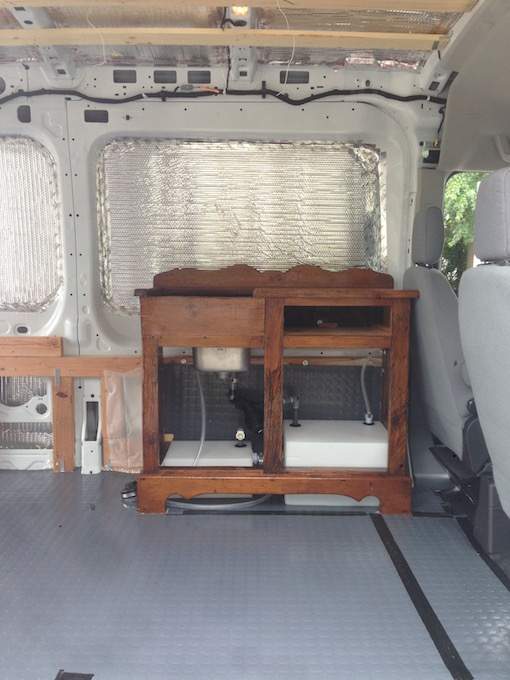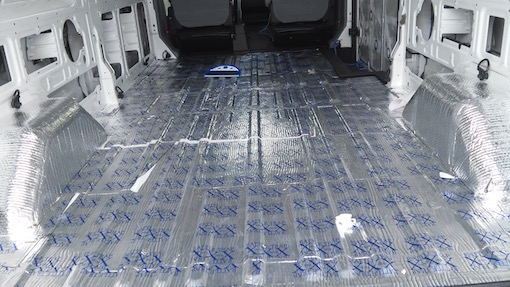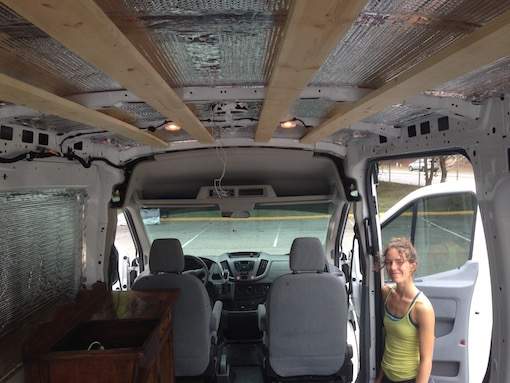Today’s post is brought to you by Sarah Coburn, a 22-year-old climber who just left New York for the west in her unfinished van. For building updates, tips and adventures follow her on Instagram @solarlunar__totallytubular. Let’s get into the topic: Vanlife Tips from a girl in the process!

Van life sounds sweet, right? No cares in the world, driving on the open road, feeling like a modern day-rock climbing-Jack Kerouac—it all sounds pretty good. Once van life starts, maybe it will be just like the climbing movie trailer of your dreams. Maybe your life will turn into a montage of sunshine and cruising your projects. But first, there is work to be done. And lots of it. My partner and I are in the process of creating our home on wheels in a used Ford Transit van. We were psyched when we first got it, and we had no idea how much work it would take.
I am writing to share some of what we have learned so far, through lots of trial and error. This list is to give you the beta on some things you may not expect when pondering #vanlife and building out your dream mobile. So, let’s get started with the vanlife tips from a girl in the process.
Moreover, find the top 3 climbing tips here!!!
1. Vanlife Tips 1/8: Don’t Rush It. Take Your Time & Plan Out A Schedule
This is huge. We bought our van about eight months ago and we are still not done building it. Granted, we were working as a team that consisted of a full-time employee and a full-time student. Throw in some unexpected events mid-summer and you get a pretty slow build. Your van build can be quicker, especially depending on how long you plan to live in it and what your home will have in it. Ours is full-on, with lots of insulation, a sink set up, two batteries, and solar panels. So between work and school, we took our time. We wanted to make it habitable for the unforeseeable future.
Whatever your vision is, do yourself a favor and write out a schedule. We started our building process without a master list. We had a bunch of small lists of course, like types of screws, plywood measurements, and random items we needed to be compiled on the back of a home depot receipt.
This is not the kind of list I am talking about. Six months in we finally sat down and wrote out every area of the van, what we needed to do in that area, and the range of dates that we would have it done within. For example, one section of our master list looked like this: “Roof: Install fans, Install roof rack. July 17-July 23”. If you stick to the list and get organized, the stress of getting the van done will be a lot more manageable.

The water system of the van
2. Important in Vanlife Tips: Research Layouts (There are a lot!)
A lot of folks are joining the (#vanlife tips) movement. The result is a plethora of van types, designs, layouts, and ideas. I have friends who live out of different vehicles and they do not look the same on the inside (or the outside). Minivans, station wagons, sprinters, VW buses, Subarus, your mom’s old Camry—they all have the ability to support your mobile climbing lifestyle. So don’t feel pressure to get anyone type of ride, they can all work. Some will be more tightly packed than others.
I have a lot of room to work with. It is still a van, however, and space must be utilized well. The layout we decided on is a lifted bed in the back of the van with room for storage underneath. Storage is really important to us because we want the maximum amount of room for climbing gear and other fun things. Above the bed, along the sides of the van, will be another shelf for clothes, etc. In the photos of our van, you can see our water system/cooking area.
It is just behind the driver’s seat and in front of where the end of the bed will be. Our “kitchen” is a cabinet that we bought at a yard sale. We covered it in epoxy and attached it to the floor. We installed a boat sink into the top of the cabinet. The water goes through the system using a foot pump, which feeds water from a nine-gallon jug of fresh water and goes into a three-gallon jug for greywater once it has been used. Since we will be spending a lot of time in the desert, we decided that a reliable water system is a pretty key.
For cooking we will be using a classic Coleman stove, which will not be attached to anything, so we can cook outside (preferably) or inside. Three roof vents that we installed will allow the indoor cooking to commence with no fume hazards. They are also important for the condensation and carbon dioxide that builds up while you sleep. One vent is passive and the other two are electric fans.
The fans are attached to two batteries, which are charged by the van while we drive it. The batteries will go under the bed. When we aren’t driving, the fans will be powered by a solar panel on top of the van. We have yet to figure out where to put skis and bikes but we are working on it!
That is just one way to build a van, however. As I said, there are many ways to go. Lots of people have done this, and no two vans are exactly the same (unless you just buy an RV). Research different van builds before you start and see which one you like best. Pick different parts from different builds to make your own.
A great place to start is by googling “van build” and you will immediately find a bunch of incredibly helpful sources. Lots of times if you reach out to the people behind these vans, they will respond and help you! And of course, the biggest help of all will be there with you throughout the entire process: the Internet.

A view of the ceiling
3. Food Dehydrator. Get One!
These (vanlife tips) are for pre-departure. You probably won’t want a large food dehydrator along for your journeys. My partner, the amazing human being that he is, had the foresight at the beginning of this endeavor, to buy a food dehydrator. They cost about $65.00, which may seem like a lot at first, but think of all the vegetables that a) you won’t have access to in remote places and b) you won’t want to spend money on at some high priced farmer’s market when you do have access.
We have been dehydrating vegetables and fruit for the past eight months, vacuum-sealing them and throwing them in a sack where they have been accumulating. Currently, we have 30 pounds of dehydrated plant material. As a vegetarian, this makes me very happy. I have thought about those long stretches of desert road with one gas station for miles that only sells beef jerky, more than once. The almighty food dehydrator has put my worried veggie mind at ease.
4. Look Into Your State’s Vehicle Insurance Policy Well Ahead of Time
I bring up this point mainly because I am from New York. And things in New York can be unnecessarily complicated. It is very silly. We learned that the minute we put a bed in our van and slept in it, our insurance would be totally void. Huge bummer because the bed is a pretty integral part of #vanlife (vanlife tips). We are really lucky because my partner’s parents recently moved to Utah and Utah’s vehicle insurance policies are a lot more relaxed.
His permanent address is changing to their address. We were very fortunate with all that business and I implore you to look into your state’s vehicle insurance policy early on in your planning.
5. Enlist Help!
Help is never a bad thing. If you don’t know how to do something, do a little digging, read a book and ask someone who does know. Before building a van, I had no knowledge of my friend’s wide-ranging skill sets, but once we started talking to people about our van, they started mentioning talents they had that could be helpful to us. We realized that when we asked for help, we were met with willingness and ability.
I had never used a jigsaw before this build (See? Really—No idea what we were doing) but my Uncle is a pretty handy guy. I asked him for advice on how to cut and install the plywood for the floor of the van and he was more than happy to help. With his guidance, we banged out the floor in an afternoon, something that would have taken me hours of trial and error. My partner has a good friend who knows a lot about aquariums.
He was psyched to help us with our water storage, tubing, and sink setup. He has helped with a lot more than that. Yet another person we know has solar installation skills.
So, ask around. You never know what skills your friends have in their back pockets. You are not alone in this crazy thing, and chances are people will want to help you. People think van life is amazing and they think you are awesome for doing it!

Wahoo-floor insulation finished!
6. Insulating Is A Process
Insulation should be a huge priority in any van. But know that it is a slow, sticky and long process. We put in so many layers of insulation that it felt like we would never do anything else. Both sound and heat insulation were important to us. Our van is pretty large so when we drove it without sound insulation, it sounded like a huge tin can, with pots and pans rolling around inside. We also wanted to be comfortable in all weather conditions so we put a big emphasis on heat insulation. Cooling in the desert and warm in the mountains.
It was well worth it, but it takes a really long time and painstaking attention to detail in order to install it well. I myself am not super patient, thus this stage of building felt like it took a few years. But I am so happy that we did so many layers. On the hottest weekend of this past summer, I got into the van in the mid-morning sun and it was cooler than the inside of my friend’s house. Pretty sweet.
Insulation is also pretty expensive. Dynamat and Reflectixxx are two name brands that are excellent at what they do, but they also cost a pretty penny. Getting a knock-off brand of these will work just as well and hurt your wallet a little less. So, for this step of the process, pencil in more time than you think you will need.
7. What Do You Have To Offer? Make That Money!
Money is the number one reason that people don’t take off for the rest of their lives to go climbing. When you really think about it, the only thing stopping everyone from moving into vans and getting after it is little pieces of paper that have old white dudes drawn on them. But enough musing about society and its arbitrary currencies… Let’s get back to van talk! I have a very small amount of savings and I needed to figure out how to keep that green coming in while living in a van.
My goal is to make enough for gas and food. So, I thought about my skill set and what I have to offer. I am a certified yoga instructor so I teach donation-based classes whenever and wherever I can. I also started finding work as a freelance writer via upwork.com. Upwork and sites like it are for people who work remotely. Both freelancers and clients use these sites to find either a job or someone to do the work that they need to do.
There are jobs ranging from six months of editing an academic journal, to coming up with fun names for someone’s new line of tank tops. Although it is more time-consuming, seasonal work is a great way to make money, too.
I have lots of friends who live out of cars and work for various outdoor education companies and conservation groups. You commit a few months, get paid, and then go back to climbing. Whatever your skillset, if you do a little digging, making some money, even if it is just enough to eat, is better than not.

The (almost) finished product
8. To Pack or Not to Pack? Finding The Balance
Van life inevitably brings on thoughts about space. How much room is there actually? How much is too much to bring? Or too little? Do you have everything you need or way more than you need? Necessity means really different things to different folks. For example, most people think of having a home built into the ground as a necessity. Chances are you are not one of those people who have read this far down into the article. But even within van dwelling types, there are differences in what is thought of as a need vs. a want.
There is no right answer. Finding the balance of needs and wants is an individual process that will take time and thought.
Before you head out (way before you head out) start the shedding process. Sit down, with all your stuff and ask, “Do I use this? Do I need this? Will I want this?” Keep the stuff that comes up as a yes to all these questions. The other stuff should go to friends, charities, craigslist and tag sales. Paring down can also be pretty lucrative. My partner held a tag sale and made money off of stuff that he either made (like ceramics) or found (furniture left on the NYC sidewalks).
A good rule of thumb for what to actually bring is one of each. THE bowl. THE spoon. THE pan. Clothing is a little less cut and dry. I err on the side of packing less, even before van life, but that’s just me. Figure out your own needs and rhythms as you go! Our priority is on gear. Having room for climbing gear ranks a lot higher than having those extra three t-shirts. So rank what is most important to you and happy packing!
Climb on!
Sarah






